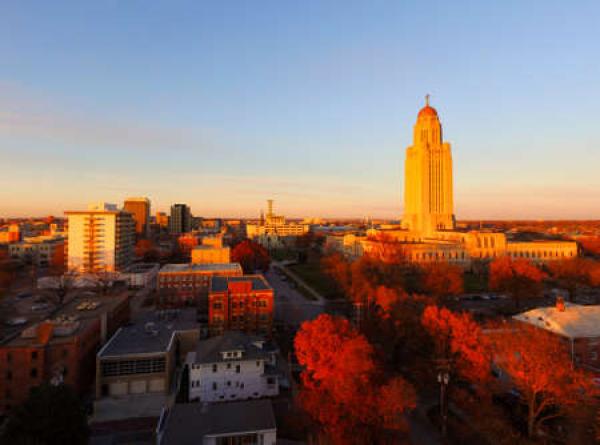
Students at Purdue University’s Polytechnic Institute and College of Engineering recently completed their first academic year in the newly constructed Dudley and Lambertus Halls. The two halls make up the Engineering and Polytechnic Gateway Complex, shared by Purdue Polytechnic and the College of Engineering. This new facility has brought these two groups of students together in hopes of fostering collaboration for years to come.
“I know our Polytechnic faculty, staff and students are proud to work and learn here,” Purdue Polytechnic Dean Daniel Castro said at a dedication ceremony in April 2023. “I also believe this facility marks a major inflection point, [and I am] thrilled about partnering with and sharing this facility with the College of Engineering. There will be [opportunities] for collaboration among faculty and students that I wish existed when I was an engineering student here 20 years ago.”
The genesis of this collaboration took place for more than five years. Here’s the key information on the process and the project.
Planning and Construction
The Purdue University Board of Trustees approved the project back in the middle of 2019 and construction began in early 2020. First came the demolition of two previous academic buildings – the Nuclear Engineering Building and Michael Golden Labs, which dated back to 1910. The new facility was then constructed on the space where those structures once stood, and are buttressed by Knoy Hall of Technology, the other major facility dedicated exclusively to the Polytechnic Institute. Construction was completed by April 2023, with the first full semester of classes kicking off in fall of that year.
The planning and construction process featured a collaboration between Ennead as the design partner, Fink Roberts & Petrie as the structural engineer, Schneider Geomatics as the civil engineer, Rundell Ernstberger as the landscape architect, and Shiel Sexton as Construction Manager.
The New Facility
The two halls combine to make up the largest academic building on campus at 255,000 square feet. This massive structure cost the university $140 million to construct, much of which came from donations. Leading donors Bill and Marty Dudley and Peter and Ann Lambertus were honored by having the halls named after them.
Most of the space in the facility is taken up by classrooms, labs, and some academic offices. The purpose of building this gateway complex was to provide more space for lab-centric instructional methods, increase the quality and quantity of lab space, and to bring these labs all together under one roof.
The facility features 14 new polytechnic labs that had no prior equivalent at the university, allowing for totally new, hands-on instruction the university was not previously able to offer. These labs are used by the Schools of Construction Management and Engineering Technology as well as the Departments of Computer Graphics Technology and Computer Information Technology.
State-of-the-Art Equipment
The classroom and laboratory spaces are equipped with the latest and greatest in technology and equipment. For example, the computer graphics technology students have access to powerful Alienware brand desktops, allowing them to run the most complex 3D visualization software. Dudley Hall’s construction laboratory is a complete, modular construction site all located within one facility. The engineering technology’s labs offer equipment for a wide range of subjects, from welding and robotics. The computer and information technology students have access to a cybersecurity lab, which allows them to learn about how federal intelligence agencies and research institutions operate.
Meanwhile, the facility features a “Smart Learning Factory”, which is essentially a lab that allows to students to create physical products all the way from concept to post-manufacturing data analysis.
At Construction Protection Systems, we’re proud to have played a small part in development of Purdue University’s Dudley and Lambertus Halls. Stay tuned for more updates from the makers of 1-2-3 Door Shield—the original, reusable door protection system.

 Rahal Letterman Lanigan (RLL) Racing Team recently began its third season of operation at its new corporate headquarters in Zionsville, Indiana. The state-of-the-art facility was designed to bring the entire RLL team together under one roof, a goal which was ultimately achieved.
Rahal Letterman Lanigan (RLL) Racing Team recently began its third season of operation at its new corporate headquarters in Zionsville, Indiana. The state-of-the-art facility was designed to bring the entire RLL team together under one roof, a goal which was ultimately achieved.

 The second phase of The New SLC Redevelopment Program was officially completed in late 2023, bringing the completion of the Salt Lake City International Airport one step closer. The
The second phase of The New SLC Redevelopment Program was officially completed in late 2023, bringing the completion of the Salt Lake City International Airport one step closer. The  For the past three months, Nashville International Airport (BNA) has been a bit busier than in the past. Since October, flights have been flying into and departing from a new eight-gate satellite concourse, an extension on the airport’s main terminal. The new concourse, added to accommodate increased travel to Nashville and Middle Tennessee broadly, is one part of the larger $1.2 billion BNA Vision redevelopment project that began back in 2017.
For the past three months, Nashville International Airport (BNA) has been a bit busier than in the past. Since October, flights have been flying into and departing from a new eight-gate satellite concourse, an extension on the airport’s main terminal. The new concourse, added to accommodate increased travel to Nashville and Middle Tennessee broadly, is one part of the larger $1.2 billion BNA Vision redevelopment project that began back in 2017. After years of planning, tough decisions, and construction work, the first phase of Amazon’s second headquarters (HQ2) opened for business in Arlington, VA in June 2023. The massive development, which now serves as the workplace for thousands of employees, was first announced more than six years ago. Quite a bit has happened in the intervening time.
After years of planning, tough decisions, and construction work, the first phase of Amazon’s second headquarters (HQ2) opened for business in Arlington, VA in June 2023. The massive development, which now serves as the workplace for thousands of employees, was first announced more than six years ago. Quite a bit has happened in the intervening time. For a long time, the people of Southern Colorado had to travel up North to Colorado Springs or Denver if they needed any serious orthopedic work done. With the completion of Parkview Health System’s Pueblo West Orthopedic Center last year, that journey is now considerably shorter. This comprehensive orthopedic facility offers patients in Pueblo and the surrounding areas consultation, surgery, and rehab all in the same building.
For a long time, the people of Southern Colorado had to travel up North to Colorado Springs or Denver if they needed any serious orthopedic work done. With the completion of Parkview Health System’s Pueblo West Orthopedic Center last year, that journey is now considerably shorter. This comprehensive orthopedic facility offers patients in Pueblo and the surrounding areas consultation, surgery, and rehab all in the same building. The General Assembly of the state of Virginia officially has a new home. A
The General Assembly of the state of Virginia officially has a new home. A  Lincoln, Nebraska’s historic Haymarket District has seen significant revitalization over the past few years and that trend is only continuing. Recently, Canopy Park opened its doors. This multi-family, mixed-use apartment complex in the Haymarket District of downtown Lincoln now offers a high-end living space in the midst of this rapidly growing community. NGC Group completed construction on the facility in the first half of 2023 and tenants began to move in soon after.
Lincoln, Nebraska’s historic Haymarket District has seen significant revitalization over the past few years and that trend is only continuing. Recently, Canopy Park opened its doors. This multi-family, mixed-use apartment complex in the Haymarket District of downtown Lincoln now offers a high-end living space in the midst of this rapidly growing community. NGC Group completed construction on the facility in the first half of 2023 and tenants began to move in soon after.
Recent Comments